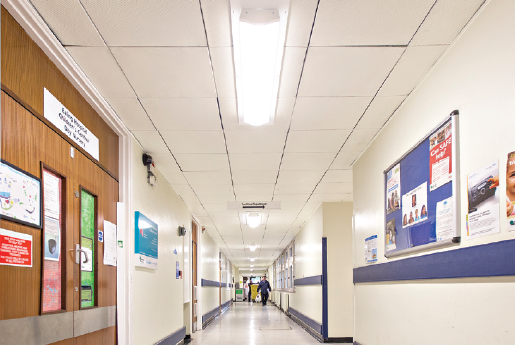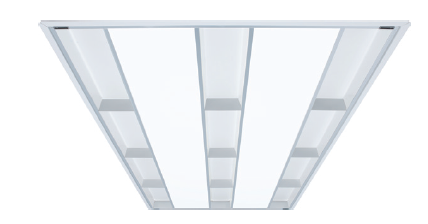 |
|
London North West HealthCare NHS Trust secured government funding to upgrade its Ealing Hospital in Southall, Greater London, to LED lighting.(All Photos Courtesy of Lumileds) |
Challenge
Due to their round-the-clock operation and high lumen output requirements, hospitals devote a great deal of their energy usage to lighting. According to the U.S. Department of Energy, lighting can account for 44% of a hospital’s electricity bill – nearly double that of a commercial building’s. In this light, it is no surprise that hospitals in many parts of the world are updating their lighting systems to LEDs to reduce their operating costs.
Last year, the London North West HealthCare NHS Trust, one of the UK’s largest care trusts that serves over 850,000 patients and employs 8,000 people, spent 9% of its total budget on energy. In the interest of reducing lighting energy and maintenance costs to relegate those savings to other forms of health care services, the Trust secured government funding to upgrade its Ealing Hospital in Southall, Greater London, to LED lighting.
The Trust partnered with the Dextra Group (Dorset, UK) to provide luminaires, controls and sensors for the upgrade. One of the substantial challenges involved the presence of imperial ceiling grids throughout the hospital, a size that is currently not offered in standard European lighting products.
Rapid installation was also considered a necessity for the lighting upgrade.
 |
Luminaires replaced in the replacement project.
|
Solution
A selection of lighting fixtures, lighting controls and sensors were chosen from Dextra plc’s Dextra Lighting, Dexeco and Dexsor divisions to meet the needs of the hospital upgrade. Dextra chose LEDs from Lumileds (San Jose, CA) because of their ability to provide very high efficacy LEDs with high flux, outstanding light quality and industry-leading reliability.
 |
|
|
Dextra replaced the fixtures in the imperial ceiling with bespoke recessed luminaires — a far less expensive approach than replacing the entire suspended ceiling. The extensive hospital upgrade included installation of 38 variations of luminaires with different lumen outputs, optics, dimming/ sensor controls, and integral emergency packages. All luminaires were specified at 4000K color temperature and 80 CRI, with the exception of the Opus 2, which is specified at 4000K and 70 CRI. All of the luminaires were designed for rapid installation and minimum interruption of work areas using cable flex and click ceiling rose design.
In the wards, corridors, stairwells and cafeterias, custom DEXLED recessed luminaires using LUXEON 3535L LEDs, with imperial dimensions of 1220 x 610 mm and 610 x 610 mm, were manufactured and installed. Due to the wide range of lumen outputs achieved with the luminaires, fewer overall fixtures were required than originally installed. The luminaire’s low brightness louvers and opal polycarbonate diffusers provided a more comfortable light for patients and staff.
 |
|
|
In the hospital wards and elevator lobbies, custom MODLED luminaires with LUXEON 3535L LEDs, also with imperial dimensions, were installed in lay-in, pull-up and surface mount configurations. The MODLED is compliant with BSEN 12464 glare limitations for visual comfort. Other luminaires used throughout the hospital included the Graduate Surface LED and Protec LED downlights, using Philips Fortimo DLM Flex modules with LUXEON 3030 2D LEDs.
In the hospital’s loading bay and nursery, the IP65 rated Avalon Wall Pack was chosen specifically for its long life and durability in harsh and hard-to-access areas. These luminaires utilize the Lumileds LUXEON T LEDs—high flux, high efficacy emitters that provide over 200 lm at 100 lm/W each. These areas also use the Dexeco ProLED luminaires powered by LUXEON 3535L, which boast a luminaire efficacy of 91 lm/W at constant lumen output.
Durability is also demanded of the Opus 2 LED floodlight, which uses LUXEON M, Lumileds brightest, most uniform high efficacy emitter. The fixture provides constant lumen output, exceeds Energy Star lumen maintenance requirements, is IP65 rated and has a die-cast aluminum housing and toughened glass covers.
For outdoor areas, the Amenity Plus LED luminaires with LUXEON 3535L LEDs provide 1500 lm or 2000 lm with light output ratios of 80%, matching the performance of fluorescent sources at a fraction of the energy cost.
Benefits and Results
Ealing Hospital officials determined that the LED lighting upgrade reduced energy use by approximately 50%. The complete upgrade was performed in 12 months. Return on investment is estimated to be reached in 5 years. All waste products were disposed of in line with WEEE legislation.
The LED upgrade provided the hospital with the opportunity to balance quality with cost-effectiveness. Rigorous compliance to the UK’s current legislation and energy efficiency and safety standards ensured that the new installation would operate in alignment with the Trust’s performance goals and environmental policies.





 CN
TW
EN
CN
TW
EN









